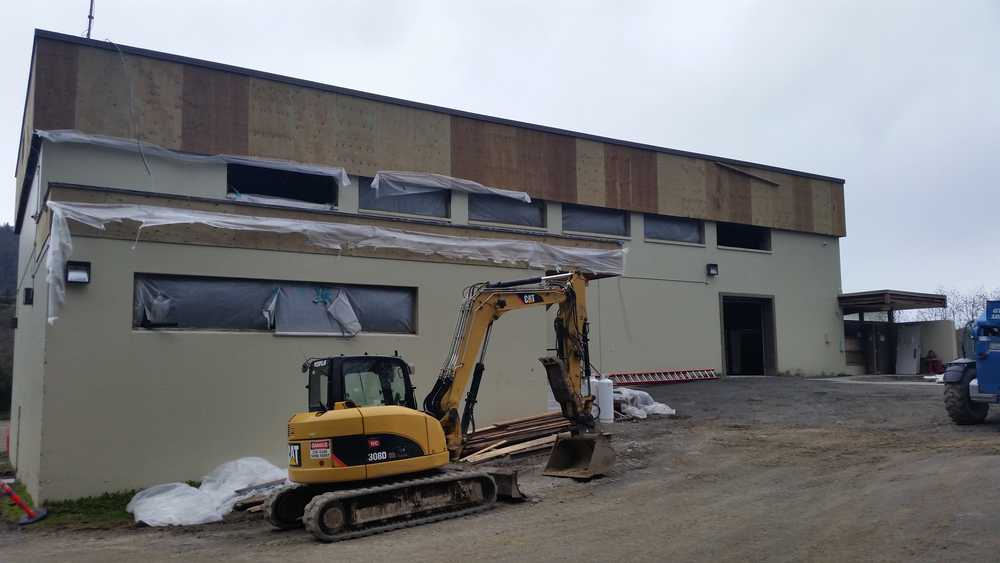The students at Seldovia’s Susan B. English K-12 school have been welding and wood working outside or in a temporary setup for the past two years while they wait for classes to resume in their shop that was nearly destroyed by a fire in 2014.
Restoration began on the reinforced concrete frame of the former facility in February and is slated to finish up by August. Next fall, Principal Alan Haskins will expand shop sessions and services to the nearby communities of Port Graham and Nanwalek, and kids will be back in a structure designated for learning what he believes is an essential skill set.
“We are looking forward being able to offer hands-on, career-ready classes for the students of Susan B. English,” Haskins said. “The shop will be updated with new electrical and the interior will have a better flow for classes. Also, there will be new safety features such as a sprinkler system and upstairs bathroom.”
Haskins started as an administrator at the school right before the fire, caused by spontaneous combustion, occurred.
Rags or paper towels soaked in Crisco — pure canola oil — were left in a garbage can, said Kevin Lyon, director of the Kenai Peninsula Borough Capital Projects Department, citing the incident’s fire marshal report. There were metal containers available in the building where staining materials are usually thrown.
“The fire does not have an incendiary cause,” according to the report. “No one was seen on the surveillance video entering the shop or being in the area of the fire for several hours prior to the fire. The most probable cause of the fire is accidental. Spontaneous heating can occur in situations with paper and cloth soaked with vegetable oil.”
According to the report, Kenai Peninsula Borough School District Maintenance performed an inspection in the fall of 2014 and no fire alarm or sprinkler systems were installed in the building.
The shop was built in 1957, originally functioning as a multipurpose room, locker rooms and a kitchen, and was repurposed into a shop in the 1970s, according to the borough’s capital projects webpage. The latest reconstruction includes restoring the structural capacity of the roof truss, fire suppression, lighting systems and the dust collection system as well as bringing it up to code.
“The building met the code it was constructed under — however, it would not have met current building code as now sprinklers are required for educational facilities,” Lyon said.
The shop was built with reinforceable concrete, which is why the skeleton of the building was salvageable, he said.
“It could be hit with a bomb and it wouldn’t go down,” Lyon said.
Incidentally, the accident saved the borough roughly $1 million in future liability, Lyon said. Panels containing facia transite, or asbestos, received smoke damage and were required to be removed, along with all other asbestos in the facility during reconstruction, he said.
“Depending on the hazards present, certain materials are required to be disposed of in (a) regulated manner. An example of this is that all asbestos was required to be placed in the Central Peninsula Landfill (in Soldotna) as the Seldovia Landfill is not permitted to accept that type of material,” Lyon said. “Schools also have a restriction on constructing with a hazardous material so all asbestos containing material removed for cleaning of smoke damage could not be reinstalled in the facility. This also applied to lead-based paint.”
Equipment that was destroyed during the fire included a “Powermatic 3520B lathe, tool set for lathe, radial arm saw with stand, combination sander Powermatic 31A, oscillating sander,” Lyon said.
“Other tools will be tested as many were exposed to moisture,” he said.
The total cost of the tools was roughly $3,500, Haskins said.
The total insured losses in estimated damages is nearly $4 million, and the borough paid a $100,000 deductible while $250,000 was designated for professional design associated costs, according the Jan. 19, 2016 ordinance appropriating the final allocations.
All in all, the damage was kept to a minimum because the Seldovia Volunteer Fire Department made it to the scene soon after the fire started, Haskins said. A resident, Tyler Tucker, spotted the flames coming from a shop window while driving to work at roughly 5:30 a.m. Monday, Nov. 24, 2014 and quickly made phone calls to the responders, according to the fire marshal’s report.
Right now, the school houses roughly 44 students in grades kindergarten through 12th, Haskins said. About two dozen students in the middle and high school grade levels take shop class weekly, he said. Next year, Haskins will offer Friday evening classes for students in Seldovia, Nanwalek and Port Graham, he said.
Lyon said he has encouraged the school to include other user groups because the new shop will be an updated, well-furnished facility.
Haskins teaches welding, pottery — for which the equipment is open for community use — woodworking, carpentry and 2D and 3D computer design throughout the school year. He said he tries to demonstrate how math and English skills can be relevant and applied to more hands-on activities, which some students might take more of an interest in. He said the classes prepare kids for life after school and broaden those opportunities.
Most students that graduate the school each year, between two and three on average — this year is a “bubble year,” with eight graduating — take vocational training or go on to college, Haskins said. A few stay in Seldovia to fish, he said.
He said he and the students are looking forward to reentering the new facility.
“Oh yeah, they love it,” Haskins said.
Reach Kelly Sullivan at kelly.sullivan@peninsulaclarion.com.

